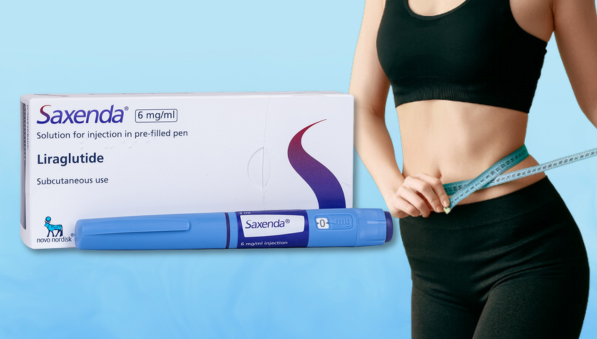Mastering Weight Loss with Saxenda: A Guide to Success
Are you struggling to lose weight? You’re not alone. According to the Centers for Disease Control and Prevention (CDC), more than one-third of adults in the United States are obese. And, despite our best efforts, many of us find it difficult to shed those extra pounds.
If you’ve been trying to lose weight without success, you may be a candidate for Saxenda® (liraglutide) injection 3 mg, a prescription medication that can help you lose weight and keep it off. Saxenda is an FDA-approved, once-daily injection that is used together with diet and exercise to help you reach and maintain a lower weight.
Saxenda is not for everyone. You should not use Saxenda if you have severe kidney problems or are on dialysis. Saxenda is also not for people who are taking certain diabetes medications such as sulphonylureas or insulin. The medication should not be used in patients with a history of pancreatitis or who are at risk for pancreatitis. Saxenda should also be used with caution in patients with a history of eating disorders.

How Does Saxenda Work for Weight Loss?
The medication works by mimicking the effects of a hormone called glucagon-like peptide-1 (GLP-1), which is released when you eat. GLP-1 signals your brain to tell your body to feeling full and stop eating. Saxenda is taken once daily, usually in the morning, and can be taken with or without food.
Patients who take Saxenda typically see significant weight loss within the first few months of treatment. In clinical studies, patients who took Saxenda lost an average of 5% to 10% of their body weight after one year. Patients who are overweight or obese are more likely to see greater weight loss.
Potential Side Effects of Saxenda
Saxenda can cause some side effects, including nausea, vomiting, diarrhea, constipation, low blood sugar, and headaches. These side effects are usually mild and go away with time.
Some people may experience more serious side effects, such as pancreatitis. This is a rare but potentially life-threatening condition that occurs when the pancreas becomes inflamed. Other rare but serious side effects include kidney problems and gallbladder disease.
Tips for Weight Loss Success With Saxenda

Here are some tips that help lose weight with Saxenda:
1. Make sure you’re eating enough. When you first start taking Saxenda, you may find that you’re not as hungry as you used to be. This is totally normal, but it’s important to make sure you’re still eating enough to fuel your body. I like to make sure I’m eating 3 meals a day, even if I’m not particularly hungry.
2. Don’t skip meals. Skipping meals will only make you hungrier later on, and can lead to overeating.
3. Incorporate protein at every meal. Protein helps keep you full and satisfied and can also help prevent cravings later on in the day.
4. Drink plenty of water. Liraglutide can cause nausea and vomiting in some people, and drinking water can help alleviate these side effects. Plus, staying hydrated is always important!
5. Avoid high-sugar foods. Foods high in sugar can trigger cravings and lead to overeating.
6. Get regular exercise. Exercise not only helps you lose weight but can also help improve your mood and energy levels.
7. Be patient. Weight loss can take some time, so don’t get discouraged if you don’t see results right away.
Reduced Calorie Diet
A reduced calorie diet is one that provides fewer calories than what you normally eat. This can be a great way to lose weight, especially if you are struggling with obesity. There are a few different ways to go about reducing your calorie intake, and a weight loss doctor can help you determine the best plan for you.
One way to reduce calories is to simply eat less. This can be difficult for some people, as they may feel like they are always hungry. If this is the case, a weight loss doctor can help you find other ways to reduce your calorie intake. For example, you may be able to swap out high-calorie foods for lower calorie options.
Another way to reduce calories is to increase your activity level. This can be accomplished by exercising more frequently or by adding more activity into your everyday life. For example, take the stairs instead of the elevator, park further away from your destination, or take a brisk walk during your lunch break.
If you are struggling to lose weight, a weight loss doctor can also prescribe medication to help. Two of the most common medications are liraglutide and semaglutide. These drugs help by suppressing appetite and increasing feelings of fullness.
If you are considering a reduced calorie diet, talk to a weight loss doctor to see if it is right for you. They can help you develop a plan that will work for your individual needs and help you reach your weight loss goals.

Exercise and Saxenda: Maximizing Weight Loss Results
You’ve made the decision to start losing weight. You’ve set your goal and you’re ready to begin. But what’s the best way to achieve your weight loss goals?
There’s no doubt that diet and exercise are key components to any weight loss plan. But if you’re looking to maximize your results, you may want to consider adding Saxenda to your regimen.
Saxenda is a prescription medication that can help you lose weight and keep it off. It’s been shown to be effective in helping people lose weight, and keep it off long-term.
When used in conjunction with diet and exercise, Saxenda can help you achieve your weight loss goals more effectively. But how does it work?
Tracking Progress With Saxenda
Saxenda is a new weight loss medication that has been getting a lot of buzz lately. It is a injectable medication that is taken once a day. Saxenda works by helping to reduce hunger and increasing feelings of fullness. It is important to remember that Saxenda is not a miracle drug and it will not cause you to lose weight without making some changes to your lifestyle. Here are some tips for tracking your progress with Saxenda.
1. Set realistic goals. It is important to set yourself up for success by setting realistic goals. If you have never been successful at losing weight in the past, don’t expect to lose 100 pounds in a month just because you are taking Saxenda. A more realistic goal would be to lose 10% of your body weight over the course of 6 months.
2. Track your food intake. One of the best ways to track your progress with Saxenda is to track your food intake. This can be done by keeping a food diary or using a food tracking app like MyFitnessPal. Tracking your food intake will help you to see where you are falling short on your calorie goals and make necessary adjustments.
3. Track your weight. Another important way to track your progress with Saxenda is to track your weight. This can be done by weighing yourself at the same time each week. It is important to weigh yourself in the morning before you have eaten or drunk anything. Tracking your weight will help you to see if you are losing weight or staying the same.
4. Measure your waistline. In addition to tracking your weight, it is also important to measure your waistline. This can be done by measuring around your waist at the narrowest point. Tracking your waistline will help you to see if you are losing inches as well as pounds.
5. Take progress photos. Another great way to track your progress with Saxenda is to take progress photos. This can be done every month or so. Taking progress photos will help you to see the changes in your body over time.

6. Track your fitness levels. In addition to tracking your weight and measurements, it is also important to track your fitness levels. This can be done by keeping track of how many steps you take each day, how often you exercise, and how long you exercise for. Tracking your fitness levels will help you to see if you are becoming more or less active over time.
7. Track your energy levels. Another way to track your progress with Saxenda is to track your energy levels. This can be done by taking note of how you feel throughout the day. Do you feel more energetic in the morning or in the afternoon? Do you have more energy on days when you exercise? Tracking your energy levels will help you to see if Saxenda is helping to increase your energy levels.
8. Track your mood. Finally, it is also important to track your mood. This can be done by taking note of how you feel each day on a scale of 1-10. Are you feeling more positive since starting Saxenda? Are you having more good days than bad days? Tracking your mood will help you to see if Saxenda is having a positive or negative impact on your mood.
Maintaining Weight Loss After Completing Saxenda Treatment
If you’re considering Saxenda as a treatment option, you’re probably wondering about the long-term effects of the medication. In other words, will you be able to maintain your weight loss after completing Saxenda treatment?
The short answer is that it depends. While Saxenda can help you lose weight and keep it off for the long term, there’s no guarantee that you’ll be able to maintain your weight loss after you stop taking the medication. That said, there are a few things you can do to increase your chances of success.
First, it’s important to understand that weight loss is not a linear process. You may lose weight quickly at first, but then hit a plateau. Don’t be discouraged if this happens. It’s normal and expected. The key is to continue with your healthy lifestyle choices and be patient. The weight will eventually start to come off again.
Second, make sure you’re getting enough physical activity. Exercise is an important part of any weight loss plan, and it’s especially important if you’re trying to maintain your weight loss after completing Saxenda treatment. aim for at least 30 minutes of moderate-intensity exercise most days of the week. But even if you can’t commit to that much exercise, something is better than nothing. Even a 10-minute walk can help boost your metabolism and support your weight loss goals.
Finally, don’t forget about the other components of a healthy lifestyle, including a healthy diet and adequate sleep. Eating nutritious foods and getting enough sleep are important for overall health and can also help support your weight loss.
If you’re dedicated to making healthy lifestyle changes, there’s a good chance you’ll be able to maintain your weight loss after completing Saxenda treatment. But even if you don’t, don’t give up. Every effort you make toward a healthy lifestyle is worth it, and you’ll be better off in the long run regardless of the number on the scale.

Questions to Ask Your Doctor Before Starting Saxenda
If you’re considering starting Saxenda, there are a few important questions you should ask your doctor first. Here are some examples:
1. Why do you think Saxenda is the right weight loss medication for me?
2. What are the potential side effects of Saxenda?
3. How much weight do you think I can realistically lose with Saxenda?
4. What are the risks associated with taking Saxenda?
5. What should I expect in terms of weight loss results?
6. How long will I need to take Saxenda in order to see results?
7. What other options do I have for weight loss?
Asking your doctor these questions will help you to better understand Saxenda and whether or not it’s the right weight loss medication for you.
References:
1. Mehta, Marso, et al. Liraglutide for weight management: a critical review of the evidence, Obesity Science & Practice. 2017 Mar; 3(1): 3–14.
2. Erondu N, Cornier MA, Gaussoin SA, et al. Effects of liraglutide 3.0 mg in combination with lifestyle intervention on cardiometabolic risk factors over 56 weeks in obese adults without diabetes: a randomized clinical trial [published correction appears in Obesity (Silver Spring). 2016 May;24(5):1169]. Obesity (Silver Spring). 2015;23(12):2375-2386.
3. Weigle DS, Sandeep V, Iyer S, et al. A randomized controlled clinical trial of liraglutide 3.0 mg for weight loss in non-diabetic individuals with obesity [published correction appears in Lancet Diabetes Endocrinol. 2015 Apr;3(4):274]. Lancet Diabetes Endocrinol. 2015;3(4):313-322.

